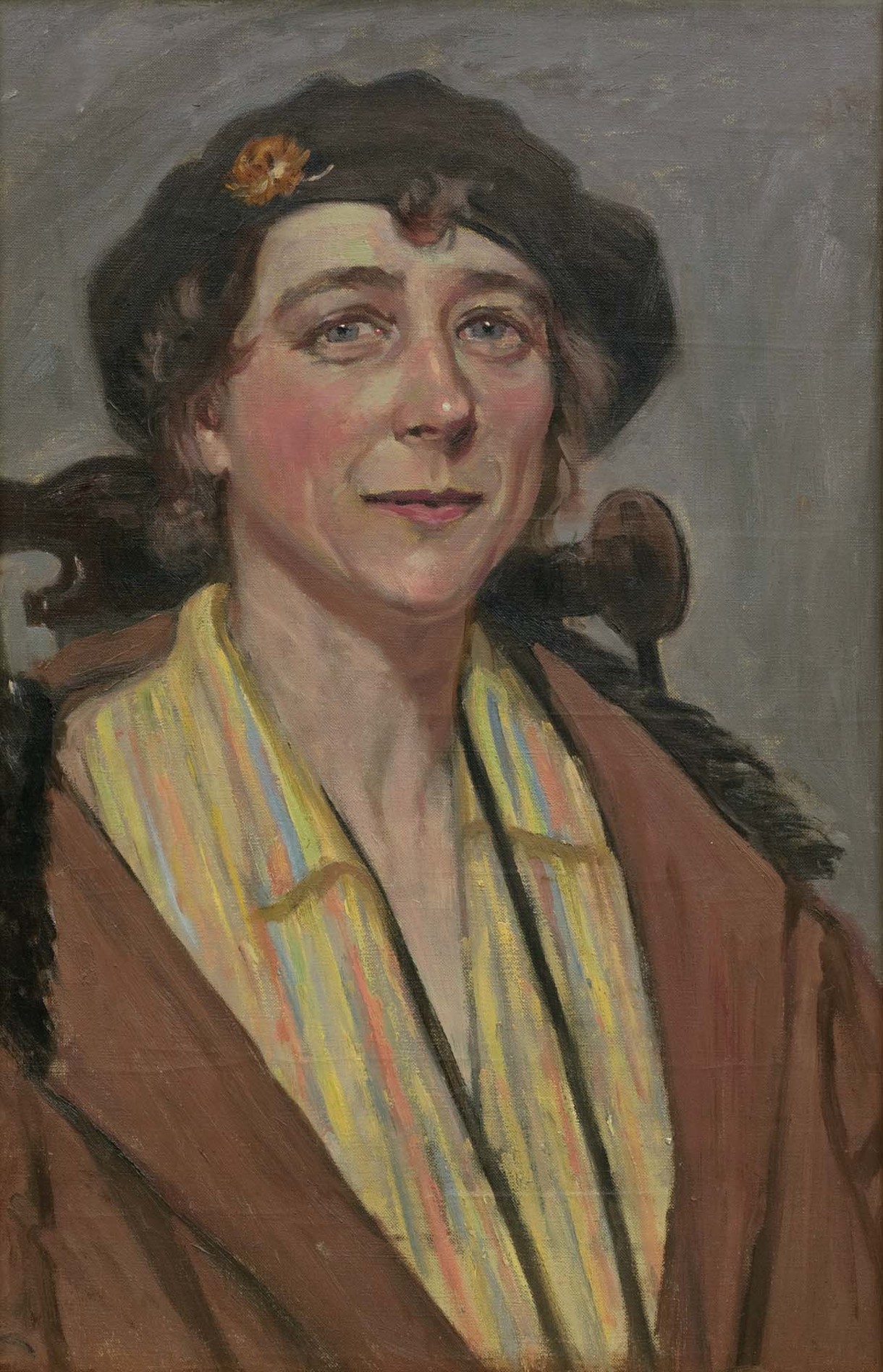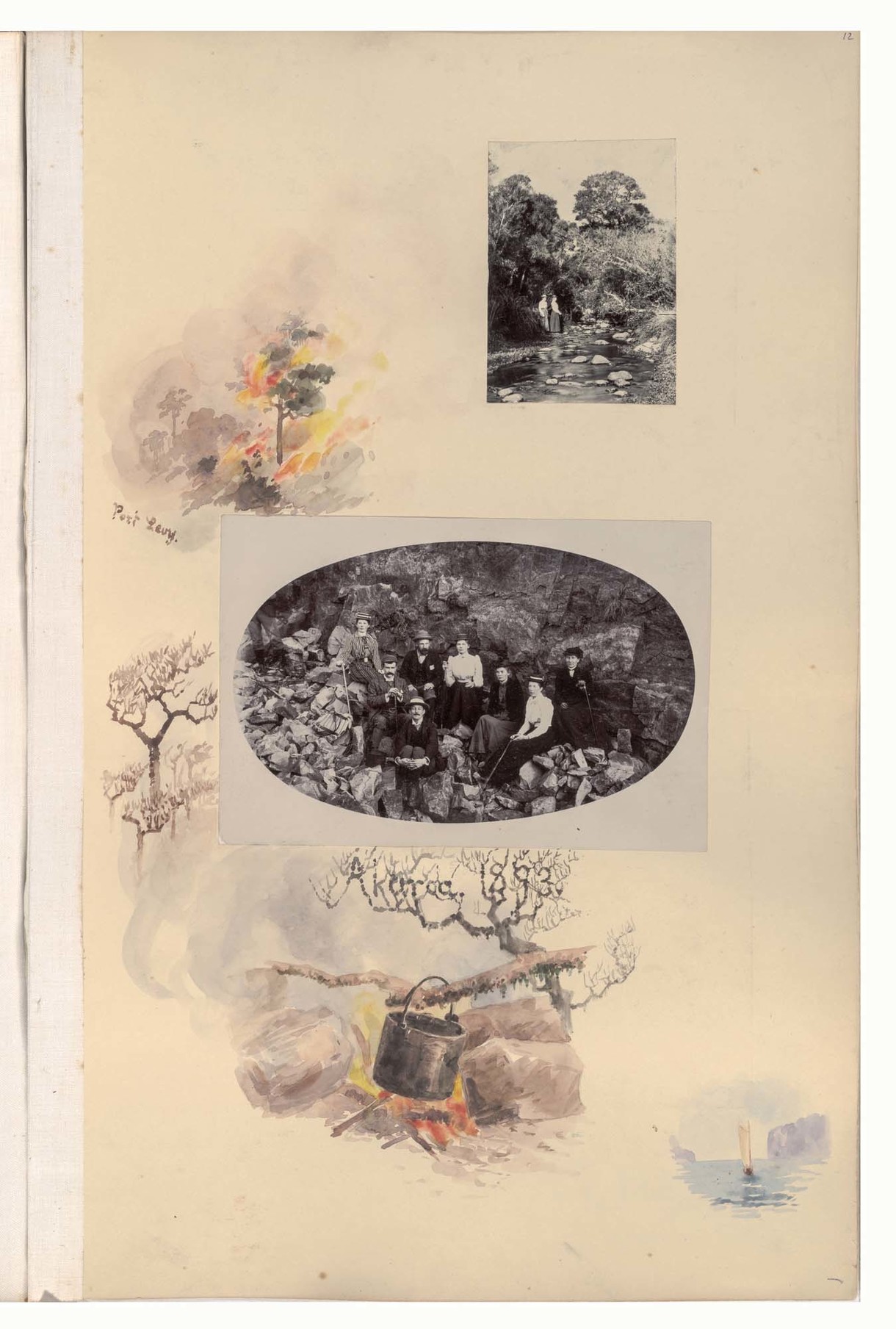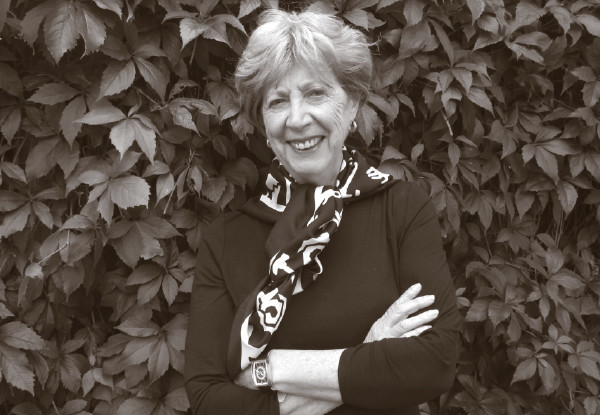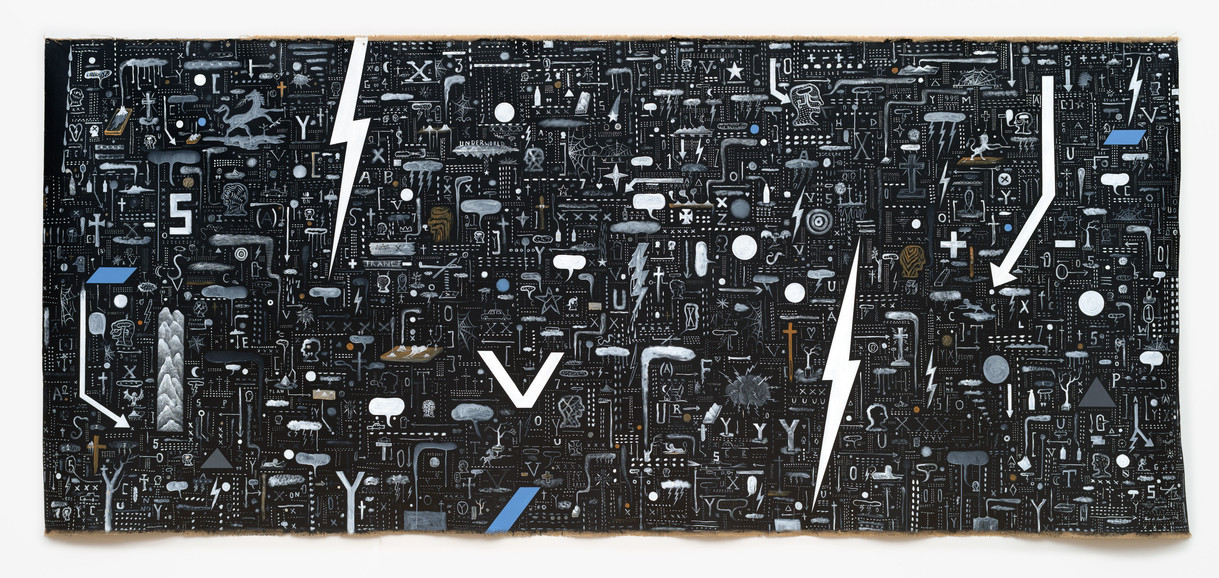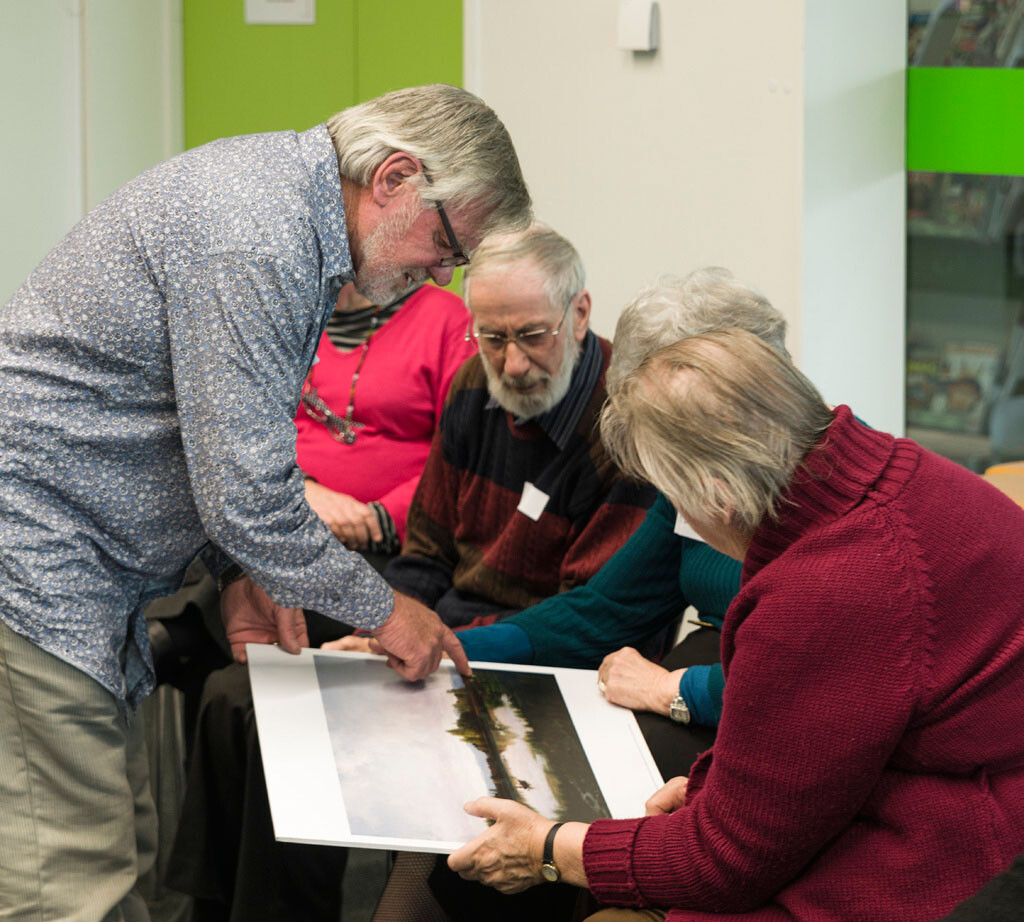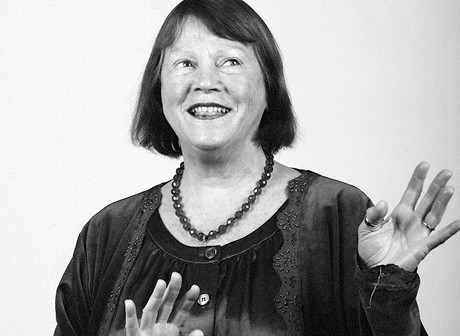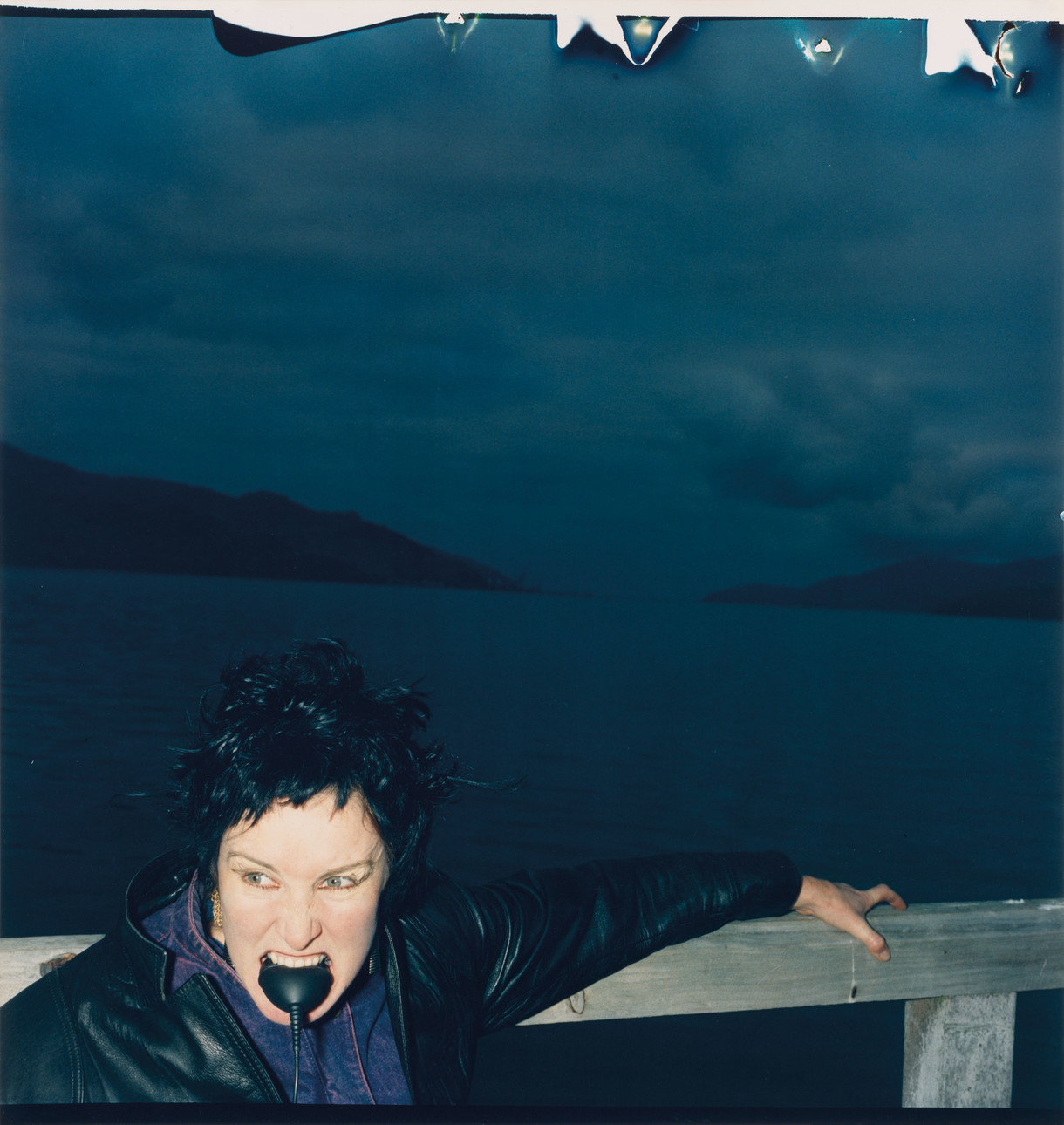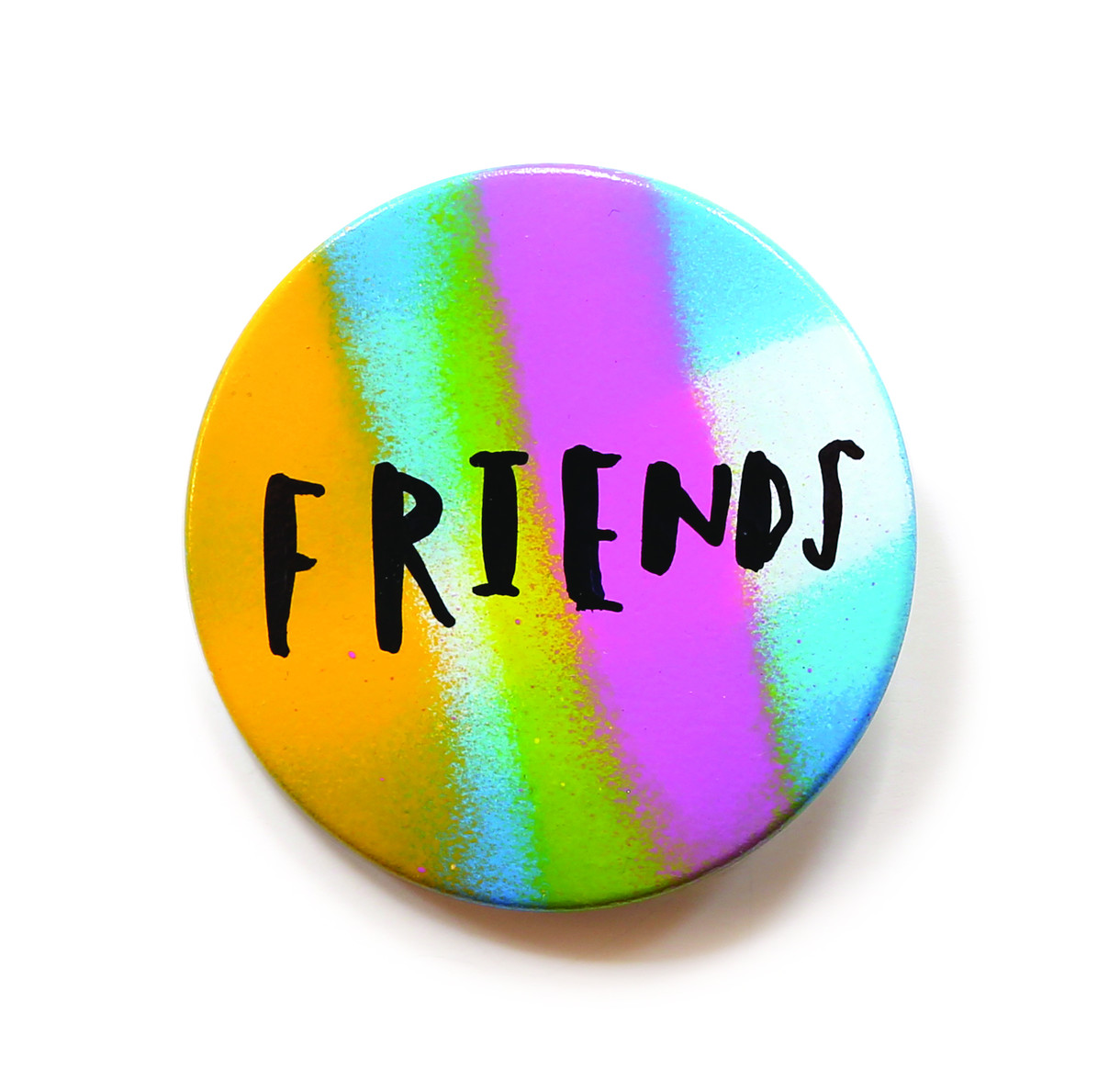Do You See?
Julie King, 1945–2018
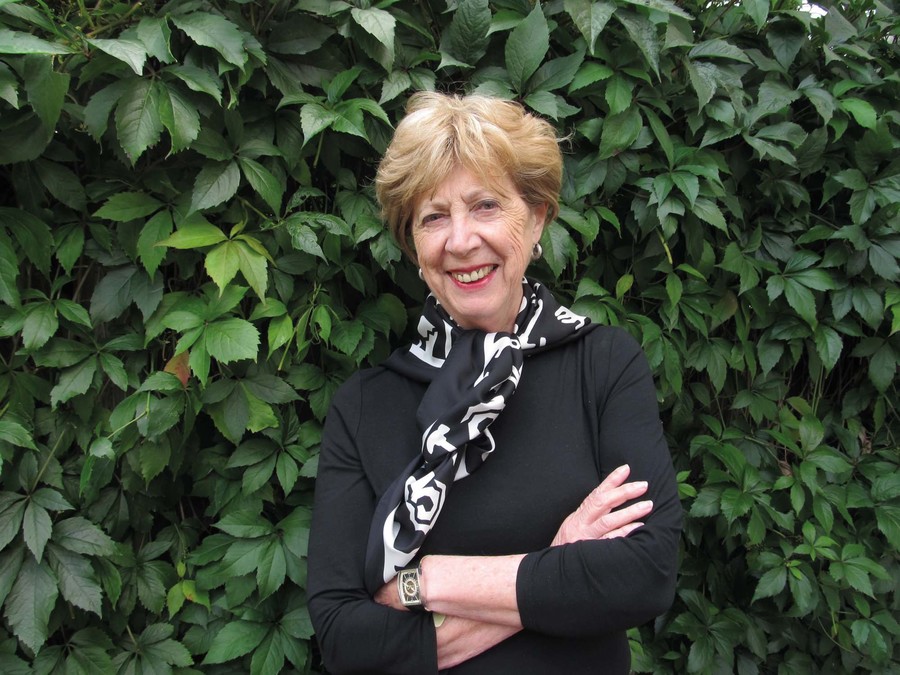
Julie King. Photo: Jenny May, 2017
With the death of Julie King late in 2018, art and art history in Aotearoa New Zealand lost one of its great champions and major scholars. Julie was born in Yorkshire and grew up and was educated in Alnwick, Northumberland; she moved to Christchurch in 1975 to take up a role lecturing in the newly formed art history department at the University of Canterbury. She retired three decades later, having pioneered the teaching of New Zealand art in Canterbury.
Julie will be remembered as a dynamic, insightful and inspiring lecturer, whose passion for her subject was engaging and contagious. “Do you see?” she would say, her eyes shining, pointing to a detail of a work under discussion. She had originally studied drama at the University of Manchester, switching to a degree in art history and archaeology, and after leaving university had lectured for a while at Goldsmiths, the Guildford School of Art and the Victoria and Albert Museum’s study centre. Her MA was on Daumier and the tradition of French portraiture, and for the first few years in Christchurch she taught French and European art, first introducing her Aspects of New Zealand Art course in 1986. A meticulous scholar, she was also interested in the social context of both the production and reception of works of art in their own time. She wrote critically well- received biographies on New Zealand artists with local connections including Sydney Lough Thompson, Margaret Stoddart and Olivia Spencer Bower, and curated several exhibitions that toured nationally.
Christchurch Art Gallery staff will miss Julie immensely. Many of us studied under her; all of us knew her, variously as the first honorary Life Member of the Friends of the Gallery, a regular contributor to our public programmes, and a constant researcher in the Gallery’s library. We enjoyed her humour and her kindness, we appreciated her encouragement and her ongoing interest in her former students—and we all benefited from her great generosity with her scholarship into New Zealand art. The number of artists at Julie’s funeral in December 2018 also testified to the respect in which practitioners held her. Julie was a modest person, who shone a spotlight on others rather than herself—and her determined scholarship brought into the light many artists, works and connections which would otherwise have languished in darkness.
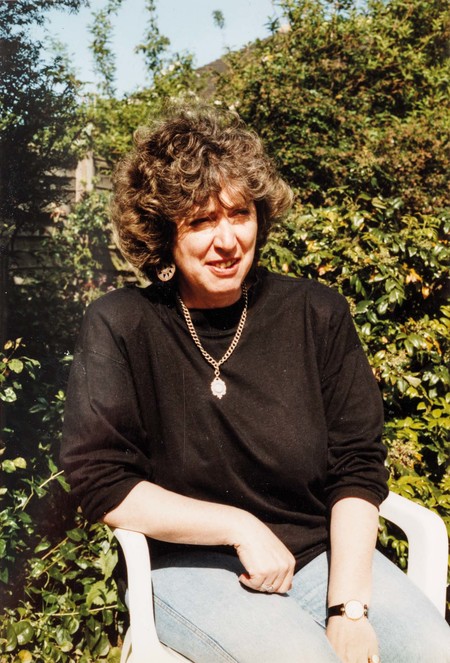
Christchurch, 1994. Photo: Jenny May
"My most enduring memory of Julie dates back to the early nineties, and her work on Sydney Lough Thompson. Tasked with delivering an exhibition as well as a book about this popular Canterbury artist, Julie quickly won me over with her uniquely gentle yet quietly insistent manner, her refined sense of humour, and her uncanny ability to somehow make me feel that it was my idea all along. Julie’s depth of knowledge and experience made it possible for concepts and designs to be adapted or edited without loss of meaning or continuity, and just about the only thing she insisted on throughout the project was eradication of split infinitives. Many years later she confessed to having been terribly nervous and unsure about the whole thing, but I for one never doubted her abilities and will forever be grateful for her mentorship and support. Rest in peace, Julie."
Hubert Klaassens
Quality assurance and heritage coordinator, Christchurch Town Hall Conservation Project
"I first met Julie in 1988 as a colleague at the University of Canterbury and was immediately taken by her warmth and her deep knowledge of New Zealand art. Professionally I knew how well regarded she was by staff and students alike and at a personal level I appreciated her good humour and generous spirit. It impressed me enormously that she transplanted herself to the other side of the world and was able to become an authority on New Zealand art and then to freely share that expertise with the art community as well as students and scholars.
As art lovers and collectors my wife and I would see Julie regularly at galleries, openings and university events and she was invariably friendly and supportive. A particularly fond memory is a visit she and Jenny made to view our collection and to advise on two Olivia Spencer Bower works. It was a lovely afternoon enhanced by a glass of wine and Julie’s gentle humour, delivered with trademark twinkle. We remember that warmth and grace as much as the generous, astute and interesting comments she made on our eclectic collection."
Jeff Field
Registrar, University of Canterbury
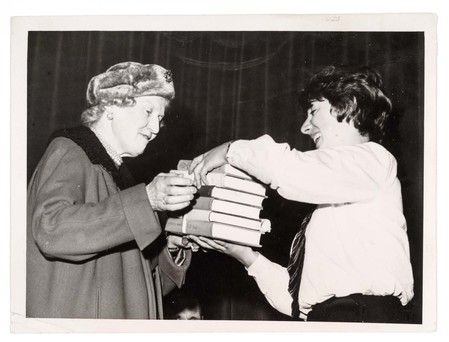
With Helen Percy, Duchess of Northumberland, prize-giving at Duchess’s Grammar School, Alnwick, Northumberland, 1963
"Julie was a terrific scholar. She circled her subject with a bird’s eye view of the wider terrain, and closed in decisively, a woman with a mission, a detective in hot pursuit of history’s crimes of exclusion and oversight. She was a particularly significant scholar of women’s art, but her method was impartial. What she did was what all the finest art historians do: she made the invisible visible, and brought the overlooked to wide public attention. Her research was impeccable. You knew that you could always rely on her scholarship. I feel profoundly grateful to have been taught by Julie; she was a model of persistence, grace and personal modesty as an academic. Those were some of the things I appreciated about her; what I loved about her was her self-deprecating humour, that sudden huge laugh that welled up out of nowhere, the moments of fun we shared over the years, doubled up laughing at the absurdity of the world and our place in it. I’ll miss Julie enormously. As will many others—she was important not only to me but to several generations of art historians trained at Canterbury. I’m privileged to have learned from her."
Lara Strongman
Head curator, Christchurch Art Gallery Te Puna o Waiwhetū
"Unfortunately, I never had the pleasure of being one of Julie’s students at the University of Canterbury. I was, however, fortunate enough to spend time with her when she was researching Olivia Spencer Bower while I was curator of the art collections there. I learned so much from Julie during those visits; her method of discussing art (and life) was generously Socratic: all possibilities were open, the conversation nipped and darted all over the place, and she really listened and made you feel as if your opinions were worth consideration. In the following years when Julie would visit the Physics Room she would enthusiastically engage with the work, eager to learn more about the artist and their practice. In her joyous reciprocity she was always an educator that empowered; a day where you encountered Julie was always a better kind of day."
Jamie Hanton
Director, The Physics Room
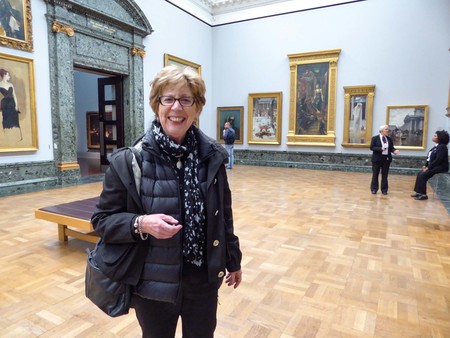
In the National Gallery, London, 2015. Photo: Jenny May
"Julie King was a very valued colleague in the art history programme within the School of Fine Arts at the University of Canterbury from the time of her appointment in 1975 until her retirement in 2004. Julie was one of the foundation art history staff at Canterbury but it is little known that she was appointed to teach Renaissance art, having studied with the distinguished British specialist on Italian Renaissance art, Professor John White, at the University of Manchester. Julie had written her MA thesis on Honoré Daumier and, with the introduction of third year courses, she began teaching the paper on nineteenth- century French art for which she will be remembered by many of her students. This was a very popular course but only partly on account of the subject matter; it was Julie’s deep knowledge of and enthusiasm for the art of this period that ensured that the course always had high enrolments.
Her interest in New Zealand art developed during the 1980s and grew out of her exploration of the links between French impressionism and New Zealand artists such as Sydney Lough Thompson, on whom she curated a pioneering exhibition in 1990. Julie’s research on New Zealand art went hand in hand with the development of new courses at both undergraduate and post-graduate levels. Her teaching was, in the best sense of the term, research-led and students appreciated the fact that they were being presented with fresh knowledge and insights through her lectures. She was also in demand as a supervisor of theses on New Zealand art topics.
The university’s art collection benefited from Julie’s keen interest in the collections that already existed— she curated a revealing show of the W.S. and Alison MacGibbon collection in 1995—but also from her efforts to add new works to the existing holdings. She played an important role as a member of the university’s art purchases committee and promoted the cataloguing and proper care of the university collection.
When Julie retired from her position at the University of Canterbury in 2004 it proved impossible to replace the unique blend of skills she brought to the teaching of Art History with a single appointment and she was greatly missed. She nevertheless remained in touch with the university and was a regular visitor in the art history department and the Macmillan Brown Library.
Her research, however, continued and she was always in demand as a public speaker at Christchurch Art Gallery, the WEA and elsewhere. Her strong interest in Canterbury women artists was reflected in the fascinating lecture she gave on Ngaio Marsh as an artist for the annual Ngaio Marsh lecture series, although sadly this research remains unpublished. Julie’s untimely death means that she was unable to bring to fruition this and other projects to which she had devoted so much time and effort. While we must inevitably regret what was not to be we should nevertheless be grateful for the valuable legacy of research and writing that Julie King has left us."
Ian Lochhead
Art historian
"Julie’s visits to the Gallery library were always a pleasure. In a sector where egos are often very well developed it was always a delight to deal with Julie’s complete lack of pretension. Her focus on the job in hand didn’t prevent our conversations ranging widely across the state of the world, music and of course above all art. Her book on Olivia Spencer Bower had a long and complicated parentage with archival material coming from a range of sources that included copies, and copies of copies. Someone less devoted to the job might have despaired but Julie created order out of chaos. I can recall her saying that she didn’t want the book to become a soap opera on Olivia’s life and family. Rather she wanted a serious book about a serious artist with, at the centre of it all, as ever, her art.
Julie combined self-deprecation and intense dedication, plain speaking with a wonderful turn of phrase. She was my best customer and I will very much miss her common sense and good cheer."
Tim Jones
Librarian, Christchurch Art Gallery Te Puna o Waiwhetū
"I often thought that the achievements of Julie King and our late colleague Jonathan Mane-Wheoki in helping to establish art history as a subject in the University of Canterbury were lamentably under-appreciated. I know 1970s Christchurch presented Julie with quite a few challenges, and the University had a very old-fashioned attitude to its female academic staff at that time. It was Julie’s enthusiasm for women artists that brought me to the University’s School of Fine Arts in 1989, to take up a lecturing post that had been fashioned by her advocacy to fit my specialism. This was a commitment we continued to share, which resulted not only in certain art history courses being offered but also in numerous research projects at Honours, Masters and even PhD level.
Julie continued to think about the state of art history in this country, nurturing it as a subject within academe and beyond. It was she who prompted us to extend our programme into the study of New Zealand art and curatorial/museum studies, both fields now expected in a degree programme but innovations in their time. She also enthused many lay-people by her activities in the Canterbury community: I would often over the years turn up to address an audience of art- lovers who had been set on their path by Julie, whom they thought of fondly. We also had in common a huge interest in nineteenth-century French painting, which Julie established as one of the most enduringly popular courses on the programme, and I much enjoyed sharing the teaching of it with her and talking over artists, topics and works of mutual fascination."
Pamela Gerrish Nunn
Independent scholar, formerly professor of art history, University of Canterbury
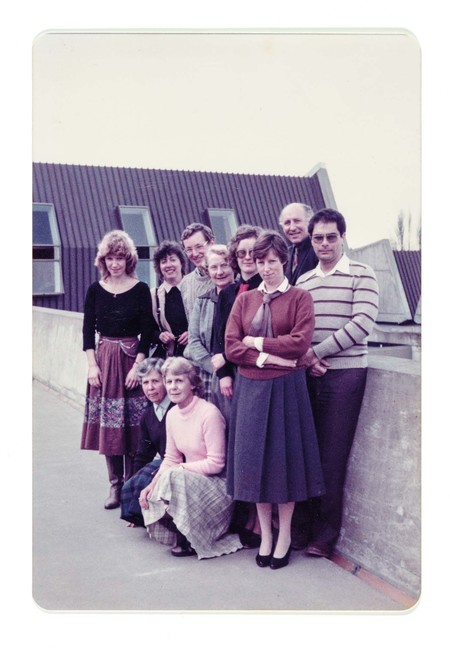
School of Fine Arts art history staff 1985. Left to right, standing: Linda Barry, Julie King, Ian Lochhead, Merle Gregor, Ann McGregor, Jillian Cassidy, Professor John Simpson, Jonathan Mane-Wheoki; kneeling: Brya Truscott, Victoria Stafford
"If nineteenth and early twentieth-century New Zealand painting was a botanical garden, Julie would be the person bringing our attention to the blooms of Canterbury. She was something of a rose herself, in that her soft and gentle nature was juxtaposed with a keen observation and sharp intellect. In conversation she had the unnerving art of posing questions which might challenge your thinking or bring to light the glib and clumsy nature of a comment you were responsible for. Aside from her writings, perhaps the work of Julie’s that I admired most was her curation of Fiona Pardington’s Echo at Riccarton House for SCAPE in 2004 (I think she also helped with Tessa Giblin’s curation of Reuben Paterson). I was similarly surprised by and appreciative of her purchase of a work by Andy Leleisi’uao for the University’s collection.
I know as a team Julie and Jenny have been a powerhouse of support to artists and people working in the arts both locally and nationally. My contact with her was limited so I recognise her contribution primarily as a teacher, part of a faculty comprised of excellent art historians who were progressive in their programming (I’d say the most progressive in the country at that time) and passionate about New Zealand’s art history and narratives. The department also had a proportionately large staff of strong academic women. When I first studied art history in the eighties I think Julie was teaching French painting; when I returned in the nineties she was lecturing on nineteenth- and early twentieth- century New Zealand painting with a section on Canterbury painters. She has to be admired for the depth of primary research undertaken both for her teaching and for the publications she produced.
While we sometimes came at things from different angles, Julie was a kind person, an excellent art historian, feminist and role model. I liked her very much. As happens with shared learning experiences, those who really felt inspired by art history, teachers and fellow students were part of a familial bond which span a great many years. I know her pastoral care for her students had a huge impact personally and encouraged careers within the arts."
Stephanie Oberg
Freelance curator and writer
"One of the most distinctive aspects of Julie’s teaching was the way that she spoke. Not just the emphasis she put on particular words—Doncaster, Canterbury— but her gentle insistence on looking hard at works of art, rather than just reading what others had to say about them. 'Do you see?' she would ask searchingly, at the end of an hour spent listening to me stumbling my way through a sight translation of Jules-Antoine Castagnary’s reviews of the Paris Salon to glean meagre comments on Courbet, 'as a critic, he draws attention to the paint itself, as well as what is painted.'
Missing that voice when I heard that Julie had died, I hoped to find it again in the prose of her meticulously researched books on Canterbury artists. But it wasn’t until I read her review of the 1985 McDougall exhibition Artfull for the Press that I heard it clearly. Zeroing in on the work of nineteenth-century women artists, she laments their works’ return to the purdah of collection storage at the end of the summer collection show like Demeter mourning Persephone, describing Henrietta Rae’s Doubts as being 'carried off, screaming' and Henriette Brown’s La Lecture de la Bible as 'descending, sulking'. By the end of the article she has succinctly made the case for a new gallery to display these old favourites, and also quietly underscored the neglect of the small grouping of French paintings as 'a dead collection' awaiting a change of taste to occasion resuscitation. This was her niche, polishing up the gems she discovered neglected in a Canterbury corner; artists who, like her, were expatriates, with an affection for France, and who were more often than not, women. She taught me the value of mining an archive and carefully structuring an argument from its footnoted details, and I will be forever grateful for her encouragement and example."
Linda Tyler
Convenor, museums and cultural heritage, University of Auckland
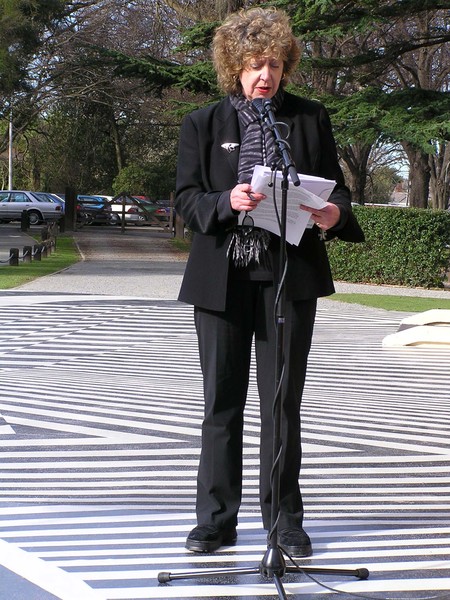
Speaking at ECHO exhibition opening as part of SCAPE Public Art Biennial at Riccarton House and Bush Putaringamotu in 2004
"When I began my studies in the art history department in the mid 1980s, Julie had already been at the University of Canterbury for ten years and had established herself as an extraordinary educator with a deep interest in exploring the stories, encounters and social settings behind artworks. As proud art history students, we were mesmerised by her knowledge, curiosity and enthusiasm. Julie took her students out of the classroom on multiple visits to the Robert McDougall Art Gallery—this was a different way of teaching. She was incredible at telling captivating stories and looking at the sense of an artist and their life experiences. She opened our eyes to look for the social history, the conditions of the time that might have led people to paint like they had and create what they did. She would say, 'Do you see?' and 'What do you think?' giving us permission and encouragement to enquire for ourselves. We learned a lot from Julie about research skills, especially the need for primary research —she taught us to look, to think, to interrogate. Those lessons continue to carry us through our professional lives."
Robyn Burgess
Senior heritage assessment advisor, Heritage New Zealand Pouhere Taonga
"My friendship with Julie was initiated when she was collating information for her book Olivia Spencer Bower: Making Her Own Discoveries. On meeting we found that we related to each other very well, and on the strength of that our future meetings developed into conversation about things in which we had a common interest; a mutual understanding and a shared confidence.
Julie was especially interested in knowing about my interest in three New Zealand artists from the turn of the twentieth century, Ethel and Fanny Richardson and Jessie Buckland; acknowledging that they were progressive women of the period. The Richardsons as early conservationists because of their efforts to preserve native species and environments and Buckland as an individualist within the male- dominated field of photography.
As a confidante it was Julie’s understanding and insightful knowledge that was so compelling – laughter made our meetings very enjoyable amidst the heady conversation about male/female representation within the world of art and the slow evolution towards some kind of gender balance; and on a bigger scale the diminishing prejudices associated with one’s being. I thought Julie was great.
Sadness intrinsic with the life Julie gave."
Paul Johns
Artist
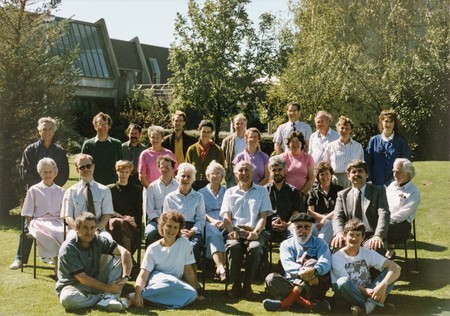
School of Fine Arts staff
"As an art history lecturer, Julie was knowledgeable, impeccably prepared and entertaining, and on a mission to give the women who were under- acknowledged in the male-dominated art narrative the exposure and context they deserved. She put that ideal into action with Flowers into Landscape, her outstanding exhibition and publication on Margaret Stoddart’s work at the Robert McDougall Art Gallery in 1997.
Julie was private and modest, motivated by enthusiasm for the work rather than glory, and she always put the artist and reader first. Her research was comprehensive and rock-solid, and like many others, I continue to benefit from the hard slog she did, poring through archives and workbooks. What I’ll remember most, though, is her warmth and generosity. She was always eager to share what she knew, or offer suggestions for possible leads. When I told her I was working with Jacqueline Fahey on an exhibition, she made time to meet with me to share her own insights about Fahey as an artist and person.
A month or so before she died, Julie came to a lecture I gave about Dora Meeson, the Melbourne-born, Canterbury-trained artist and suffrage campaigner. Julie had investigated Meeson’s work many years previously with a view to writing about her but, working in the early days of the internet, had run into lots of dead- ends. We spoke for a long time afterwards, as people drifted out and the auditorium lights were switched off one by one. With her eyes sparkling and one hand gently gripping my elbow, Julie urged me to keep trying to bring Meeson a little further into the light. 'It’s so important!' she said. 'Don’t you think?'"
Felicity Milburn
Curator, Christchurch Art Gallery Te Puna o Waiwhetū
"When I think of Julie King as an art historian one word comes to mind – 'cautious'. This is a measure of Julie’s professionalism.
I worked with Julie on exhibitions when she was a guest curator at the Robert McDougall Art Gallery and well recall discussions about works. On one occasion in 1997 when works for the exhibition Flowers into Landscape: Margaret Stoddart 1865–1934 were being considered the date of one titled House in a Summer Garden was uncertain. The conversation went something like this: Julie said to me 'Do you know the date?' and I replied 'I think it is around 1925.' Julie then said 'But do you know? How do you know? … we don’t know do we.' Where a lesser art historian might have easily speculated and decided immediately and left it at that, Julie was more cautious, would not assume, and if the evidence did not stack up would leave the question unanswered. In this case the date of the work was left unknown.
There is no question though that during the forty-three years that Julie lived in New Zealand she made an important contribution to art history. When she arrived in Christchurch in early 1975 and began teaching nineteenth-century French art she had very little awareness of art in this country, but over time, through scrupulous research, grew her knowledge and became highly regarded for the work she did, particularly on women artists such as Ellis Rowan, Margaret Stoddart and Olivia Spencer Bower."
Neil Roberts
Art historian, formerly senior curator and manager of collections, Robert McDougall Art Gallery
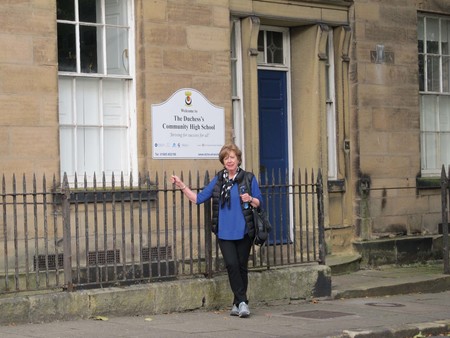
Outside the Duchess’s Grammar School, Alnwick, 2016. Photo: Jenny May
"I first met Julie when I joined the University of Canterbury as a lecturer in sculpture in February 1991. In those days the art history staff were upstairs in block two along with the administration; downstairs were the reference library, a tiered lecture theatre and a small gallery used by students as an experimental space for trying out ideas and getting feedback from academic staff and fellow students.
It was in the SFA gallery that Julie and I had our first real conversation about art. We circled the gallery in opposite directions, looking at student works and the overall installation. She nodded at me, as she so often did to acknowledge one, carried on looking and at some point we got to talking.
Julie’s first words to me on that day were 'I don’t know' and mine were, 'Well, I don’t get it.' We both laughed, as here we were, supposedly with all this knowledge and both were doubting, looking for the back story, the impulse, the feeling, the resolution.
I can remember at the time being somewhat astounded by the fact that an art historian might be even interested in student work. Julie was. She continued to regularly visit the SFA gallery, often engaging with the studio students in her determined yet supportive way, as a true teacher does. Over the next decade, we conversed about art, the local scene and what was going on across the globe. Every conversation was framed by doubt and questions as Julie incisively and gracefully probed and finally formed an image of what it was that might be there. I’m sure she saw the space in between, the space that contains all the elements in which it is necessary for art to exist.
When Julie King died we all lost a gentle and insightful person who made a valuable contribution to our understanding of the greater ambience of art."
Andrew Drummond
Artist
"I knew Julie, who was personally always JK to me, as a lecturer when I was an undergrad taking art history; as a friend; as a teacher using the McDougall collection when I was registrar; and as a curator when she requested loan works from my collection. There will be many who can attest to having enjoyed Julie’s lectures. I was one of them. Her lectures were looked forward to with enthusiasm. They were insightful, exciting and extremely learned. Her teaching demonstrated a passion for her subject matter and caring and compassion for her students. She was a mentor and a role model. As a student and also as registrar at the Robert McDougall Art Gallery it was always a highlight for me when JK would request a 'mini exhibition' from the collection for her to discuss with her students in a more intimate way these pertinent art works. I would receive the list, retrieve the works from storage and set them up for her. I recall that the students in these groups considered this a unique and special experience. But on a more personal level, I enjoyed JK’s delightful sense of humour. She could imitate differing English accents when the occasion arose and this would be evident during the many 'Coronation Street' dinners we held. These were not serious dinners but occasions for hilarity and satire over a Lancashire hotpot and other such English fare. It was an endearing side of JK.
Because of Julie King’s untimely and unexpected death, the long-overdue recognition of her contribution and commitment to the University of Canterbury and to our knowledge of New Zealand’s art history, remains to be resolved. A posthumous Honorary Doctorate from the University of Canterbury would be a fitting tribute to Julie’s talents and a recognition of the high regard and respect she holds from the many people who have known her professionally."
Anna Crighton
Art historian, formerly registrar, Robert McDougall Art Gallery
"Julie King was without doubt a superb art historian – a meticulous researcher whose writings were totally trustworthy, whose insights were offered with humility, but underpinned by evidence, wherever possible from the source. She was serious, scholarly, even proper, but also loved art passionately and had a definite mischievous – even slightly wicked – streak. One never knew when that gleam would light up her eyes, and out would come an unexpected but very clever observation. My knowing Julie coincided with the blossoming of my love of contemporary art, and with that the need to know more about all art. While at university being grounded in the sciences, art history was not only at the opposite end of campus but very much on the periphery of my interests. Julie helped overcome that. While I was never conscious of being ‘taught’ by her, I learned such a lot from her. Gently questioning, suggesting, encouraging me to think, and then think more deeply. Not giving the answer but just enough prompts to edge one towards a hypothesis. Those prompts were the key. So subtle that I felt I was being guided rather than taught. Guiding, but not at all afraid to say 'Oh no, I don’t think so!' – always followed by the next prompt, 'What about…' I’ll always be intensely grateful for the insights gained.
Julie King: a warm, delightful, deeply intelligent woman, much loved and admired."
Anthony Wright
Director, Canterbury Museum
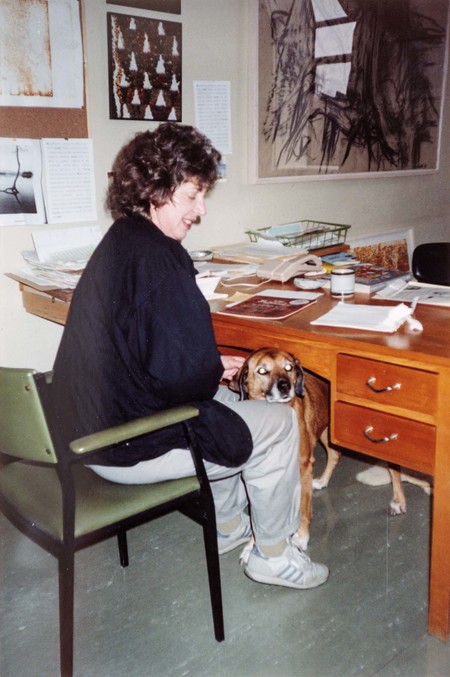
With her beloved dog Lucy at the School of Fine Arts in 1995. Photo: Jenny May
"It is an immense sadness to have lost Julie King – a great scholar, art historian, educator, supporter and friend of the New Zealand visual art world. I was an art history student of Julie’s at the University of Canterbury as part of my fine arts degree in the 1990s. I revelled in her meticulously prepared, visually compelling and beautifully articulated lectures. She introduced me to the artworks of artists in the Group, with an interest being her studies and later book that she wrote on Olivia Spencer Bower. Little did I know at the time of my graduation that Julie would play an ongoing role in the development of my twenty-year career in the visual arts. Julie and her life partner Jenny May have been supporters of SCAPE Public Art from our first exhibition in 2000. Julie enjoyed warmly encouraging her former students and checking in on where their careers took them. In 2004 I had the great pleasure of working with her as curator of ECHO, an exhibition at Riccarton House and Bush Pūtaringamotu in which new artworks were installed within the house and grounds. Julie brought together a carefully selected group of artists who produced new artworks that responded to the specifics of the site and its natural and human histories – Māori and European – to shine a light on the location’s present-day significance. The artists included Graham Fagen, Fiona Pardington, Reuben Paterson (this element was co-curated by Tessa Giblin) and Phil Price. Julie also formed the basis of SCAPE’s education programme, with two elements in ECHO made by students from Riccarton High School and Rangi Ruru Girls’ School. Julie unlocked the power of art to inspire educate, stimulate and create inquiring minds within me and many others. May her spirit and her legacy to New Zealand art history live on for many generations."
Deborah McCormick
Executive director, SCAPE Public Art
"Julie was a patron of the Friends of Christchurch Art Gallery Te Puna o Waiwhetū but her involvement goes back to the very beginning of the organisation that was the Friends of the Robert McDougall Art Gallery. At a reunion of past presidents and committee members we held as a celebration of twenty-one years in 2002, Julie talked about the discussions amongst academics, artists and others about forming a support group for the Gallery to assist with purchases for the collection and inspiring the public to learn more about their art gallery. She was key in enabling this to happen in 1981 and remained a member for the rest of her life, becoming a Patron in 2010.
Julie gave many fascinating lectures and on-site talks to the Friends over the years, and was always enthusiastic about finding yet another subject to present to the members. Her talks were always the best attended as everyone knew how much they would glean from her insight into the artists or artworks. The acquisition by the Friends of a work from the Jacqueline Fahey exhibition last year gave her huge pleasure as her admiration for women artists and the hurdles many faced was part of her examination of art history. She keenly observed the activities of the Friends, and would offer suggestions, then in her charming subtle way would say 'and what do you think should happen?'
Julie was so supportive and came to as many of our activities as she could fit in. We will all really miss her warm, encouraging smile, her ongoing concern and support for the Friends and her loving, caring manner towards all who wanted to know more about art."
Marianne Hargreaves
President, Friends of Christchurch Art Gallery
"Julie was my art history colleague at the University of Canterbury for over fifteen years and a friend for more than half my life. She was a very fine human being. I was moved to tears at her remarkable farewell, and I’m not far off it as I write this and think of her again.
As well as being a thoroughly good and understanding colleague, Julie was a terrific lecturer, who had this special gift – which I’ve likened to Barry Manilow in concert – of making you feel what she was saying was meant for you and you alone, even if you were part of a large audience. A rare gift, and one that can never be learnt or acquired. Julie was also an admirable scholar. She was a perfectionist and far too hard on herself, but this went with her essential modesty. She wrote with an authority and a jargon- free clarity that was based on diligent research and a sensitivity towards everybody and everything she studied – from Honoré Daumier to Margaret Stoddart. I was very pleased to be able to (glowingly) review Julie’s final book, on Olivia Spencer Bower, for the rather posh Burlington Magazine in the UK, and evidently she was not displeased in turn!
I’ll finish with a phrase adapted from Colin McCahon, 'Here I give thanks to Julie King'."
Mark Stocker
Curator historical international art, Museum of New Zealand Te Papa Tongarewa








